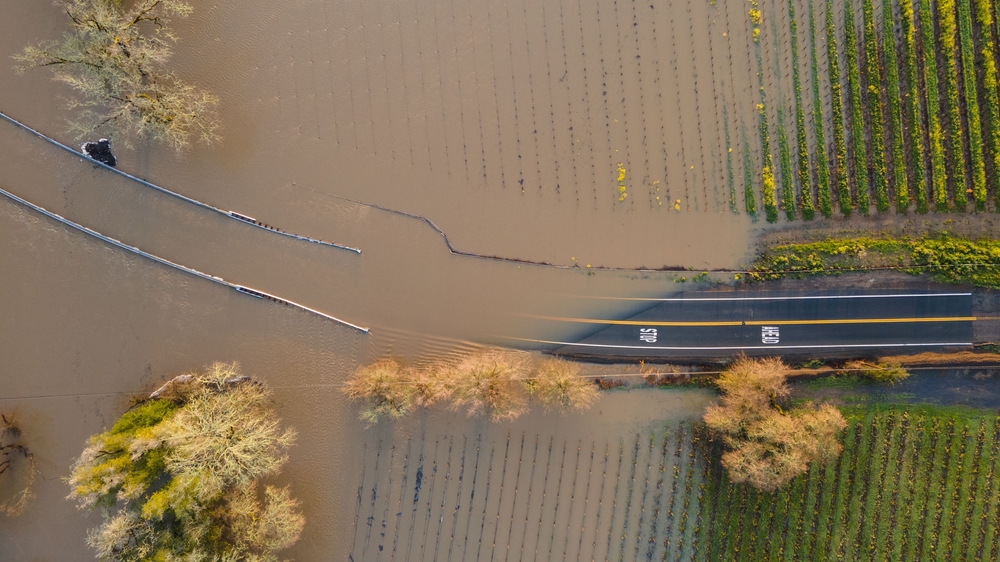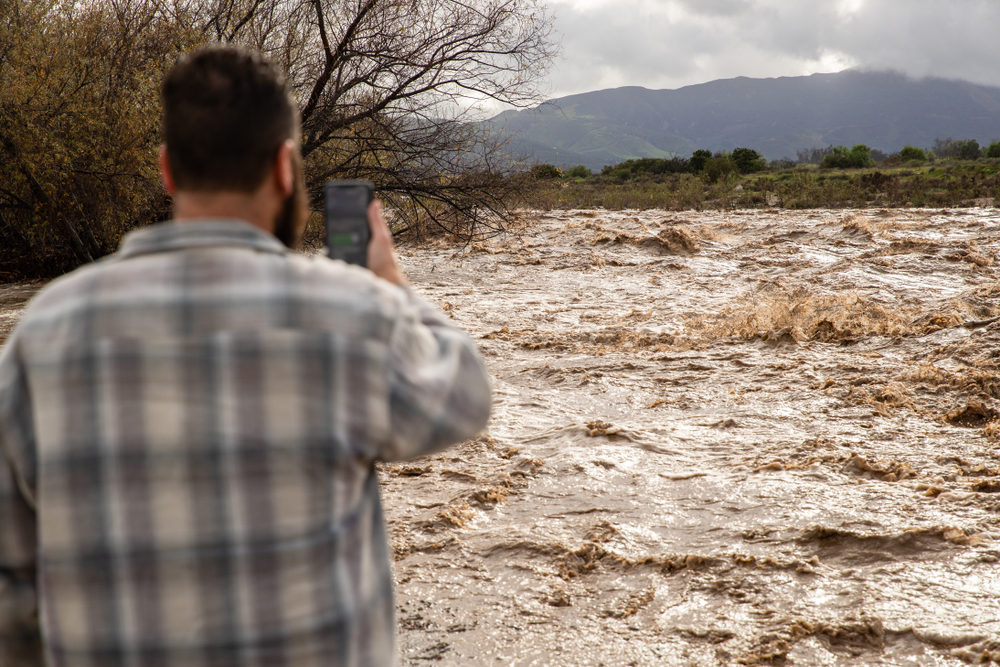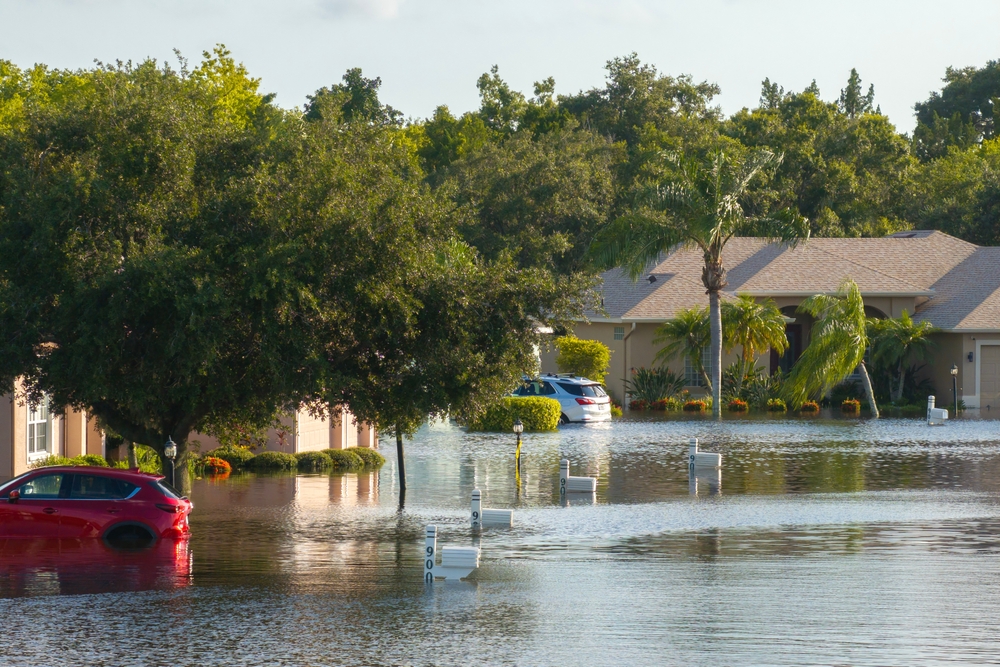Warning: California is riddled with climate and natural disasters. While wildfires and earthquakes are frequent headlines, homeowners must also be wary of flooding. From atmospheric rivers to rising sea levels, floods are a growing risk in Central Valley areas, the state’s capital, Sacramento, and major coastal cities.
In December 2024, Tulare Lake in San Joaquin’s valley re emerged after 130 years of flooding 94,000 acres of farmland. Los Angeles County also experienced urban flooding in March 2023 as a series of back-to-back storms brought unprecedented rainfall, overwhelming the city’s drainage systems with flash flooding in Studio City and South LA. In addition, Malibu experienced mudslides. Over 120,000 homes became powerless as there were electric outages due to the extreme weather. Up north in Monterey County, the Pajaro River flooded the small community of Pajaro due to an atmospheric river.
What’s an atmospheric river?
An atmospheric river is a narrow corridor of atmospheric water vapor that can bring heavy precipitation to a region. Often called a “river in the sky,” these weather systems can move large amounts of water vapor across large land areas, often dumping California during the winter months and contributing to flooding.
Atmospheric rivers are increasing in occurrence and severity and should not be taken lightly as the Office of Environmental Health Hazard Assessment (OEHHA), an organization under the California Environmental Protection Agency (CalEPA), reported that atmospheric rivers account for 30-50% of the state’s annual rainfall.
Impact on Homebuyers

First-time homebuyers will learn that FEMA-designated flood zones require flood insurance, and these premiums can vary from $700-$3000 based on elevation and flood history. Also, time on the market could be affected as flood-prone properties tend to be more difficult to sell, especially if there’s a history of damage.
- Mandatory Flood Insurance: In a FEMA-designated flood zone? You are required to obtain flood insurance, with premiums ranging from $700 to $3,000 annually based on elevation and flood history.
- Resale Challenges: Selling a flood-prone property can be more difficult, especially if damage history clouds the home’s reputation. Take this into consideration if you ever plan on selling your home.
Understanding Flood Zones and Risk Assessment

The federal government created FEMA in 1979 to assist homeowners in understanding their area’s flood risk and help mitigate potential damages from flooding. FEMA has created flood maps that designate different flood zones based on the likelihood of a property being affected by a flood. These maps are publicly available for anyone to view and can be found online through FEMA’s website or local government agencies.
- Flood Zone Designations: The various flood zone designations include high-risk, moderate-risk, low-risk, and undetermined areas.
- Risk Assessment: Homebuyers should use these designations to understand their property’s risk and take precaution accordingly- purchasing insurance or retrofitting to include flood mitigation infrastructure.
It is absolutely critical to understand where your potential home sits about flooding for the security of your purchase and your family’s safety. Many tools exist to help with that assessment.
Tools to Assess Flood Risk
FEMA Flood Map Service Center
FEMA Provides official flood zone maps with detailed elevation data. Check the map out here- FEMA Flood Map Service Center.
FloodFactor.com
This website details flood risk analysis for specific properties and has access to historical and projected data.
Department of Water Resources
The state agency, Department of Water Resources (DWR), provides another excellent resource for state-specific floodplain information.
The Impact of Flooding on Insurance Rates

Homes in high-risk flood zones often require flood insurance as part of a mortgage agreement. Flood insurance costs can vary significantly depending on location, the elevation of the property, and house construction. Typical costs can vary, and according to FEMA’s National Flood Insurance Program (NFIP), the average flood coverage is about $900 yearly. PRemiums in higher-risk zones can reach up to $2,500 each year. If you’re looking at purchasing a home at a lower elevation, be sure to check that food mitigation measures are in place, such as elevated foundations and flood barriers. Homes lacking these will likely face higher premiums.
Where to Get Coverage
National Flood Insurance Program (NFIP)
This federally backed flood insurance program serves homeowners in high-risk regions. Policies are often affordable but have coverage limits. Coverage limits are $250,000 for residential homes and $100,000 for personal belongings. Visit floodsmart.gov to learn more.
Private Insurers
National companies like State Farm and Progressive offer customizable plans or flood coverage add-ons with higher coverage limits. Costs vary, so contact a local insurance provider for more information.
Fun Fact: “Flooding is California’s costliest natural disaster, with average insurance claims exceeding $224,000 per event.”
The Role of Home Inspections in Uncovering Flood-Related Issues

Engaging a professional home inspector is a non-negotiable step when purchasing a home, especially in areas prone to flooding. Beyond standard inspections, consider hiring inspectors specializing in flood-related evaluations to uncover drainage issues, compromised foundations, and any past flood damage.
Identifying Signs of Potential Flooding in a Property

When house hunting, watch for signs that a property could be at risk of flooding:
- Water Stains: Look at the walls, window sills, and basements for discoloration. A fresh layer of paint might cover this.
- Foundation Cracks: Cracks are a massive sign of structural damage. Cracks may indicate water damage or shifting due to floods.
- Poor Drainage: Check for water spots near the property; this could mean inadequate drainage.
- Flood History: Be sure to obtain past flood damage information from the seller or your realtor. Tools exist to support this; check out FloodFactor to discover any flooding history.
Work with a qualified home inspector to identify these often-hidden risks. Asking questions about what to look out for can also help educate you about flooding and mitigate potentially significant costs.
Mitigation Strategies and Floodproofing Your Home
If you decide to purchase in a flood-prone area, you can take steps to reduce risks and protect your home.
Key considerations:
- Obtain an elevation certificate to understand your home’s flood risk and potential insurance cost.
- Speaking of elevation, elevate key components of your home, such as your HVAC system, water heaters, and electrical units.
- Shop for good design, keeping an eye out for houses with raised foundations or modern drainage systems, mitigating water damage.
- The budget for flood insurance could be $60-250 a month, depending on your location. This is on top of your regular home insurance premium.
- Plan on installing a sump pump to remove amassed water in your basement, the event of flooding.
- Waterproof your basement, sealing foundations and walls to keep water out.
- Install flood vents to help water flow freely under your home, thus reducing structural pressure.
If you’re looking for more resources for floodproofing, check out the FEMA Homeowner’s Guide to Retrofitting and the California Residential Mitigation Program (CRMP).
Helpful Resources
Here’s a list of helpful resources to support first-time homebuyers (and homeowners) in flood-prone areas.
These grants provide funds for adding flood-mitigation infrastructure, such as by elevating homes.
California Disaster Assistance Act (CDAA)
The CDAA offers financial assistance to local governments and eligible homeowners for post-flood recovery. Check to see if you quality.
California Residential Mitigation Program (CRMP) Financial Incentives
The CRMP offers financial incentives to homebuyers to increase their mitigation infrastructure for natural disasters, including flooding. Partnering with FEMA, the CRMP provides Flood Mitigation Assistance (FMA) to help homeowners retrofit to reduce flood damages.
This website allows folks to analyze property-specific flood risks with historical data and future projections.
California Department of Water Resources
This state agency gives access to floodplain information as well as mitigation programs.
FEMA Homeowner’s Guide to Retrofitting
This homeowner’s guide advises on floodproofing and elevating homes.
This resource provides options for flood insurance for military families.
State Farm as well as other national providers, offer private flood insurance options with higher coverage limits.
So… finishing things up…
This guide, along with its resources and programs, is designed to support first-time homebuyers and current homeowners in addressing the risks of flooding. Using this guide during your home-buying journey, you’ll better understand the challenges associated with living in California, particularly in flood-prone areas.
Whether drought or flooding, climate change continues to exacerbate climate disasters. Mitigation is critical!
The wise homeowner will stay informed and take proactive and preventative steps to protect their family and dwelling from potential flood damage. With vast resources to help you retrofit your home or obtain flood insurance, you should feel equipped to face homeownership in California.
Ready to move forward? Contact your local realtor or consult an insurance professional to learn more options that are suited to your situation and safeguard your future!


